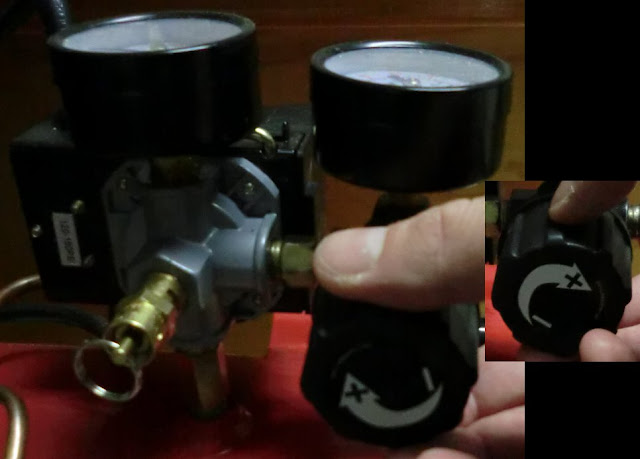The way compressors and tanks work is they’ll have a minimum and a maximum pressure. (sometimes this can be adjusted on compressors)
A tank’s minimum pressure will be the same as the air around you – that’s 0 psi. (so, technically, “0 psi” is actually a different pressure depending on where in the world you live – but that doesn’t affect how your airbrush/compressor works, just a random bit of info) The maximum pressure for a tank is the point where it’ll start to bulge, crack and worst case – blow. (Though odds are that your meters and valves will leak out first) For safety reasons, compressors will usually stop filling a tank before it gets to that point.
A compressor without a tank is set (by you) at the pressure the airbrush requires and just runs until it’s turned off or overheats.
A compressor with a tank built in is configured by the manufacturer to turn on if the pressure is lower than a certain point and turn off when it reaches another point. (Some compressors will allow you to adjust the both these points) For example:
Adjusting pressure while in use
A tank’s minimum pressure will be the same as the air around you – that’s 0 psi. (so, technically, “0 psi” is actually a different pressure depending on where in the world you live – but that doesn’t affect how your airbrush/compressor works, just a random bit of info) The maximum pressure for a tank is the point where it’ll start to bulge, crack and worst case – blow. (Though odds are that your meters and valves will leak out first) For safety reasons, compressors will usually stop filling a tank before it gets to that point.
A compressor without a tank is set (by you) at the pressure the airbrush requires and just runs until it’s turned off or overheats.
A compressor with a tank built in is configured by the manufacturer to turn on if the pressure is lower than a certain point and turn off when it reaches another point. (Some compressors will allow you to adjust the both these points) For example:
- Before turning on the compressor, make sure all valves are closed.
- Turn on the compressor.
- If you're using a tank, wait until the tank fills. The compressor should automatically turn off once this happens.
- Slowly open the valve while watching the pressure gauge, turning until it reads the pressure you want.
- As you use air, the pressure in the tank lowers.
- When the tank pressure lowers enough to hit the compressor’s minimum pressure level, the compressor will turn itself on again and fill up to the max value. (If you have left the compressor’s switch on)
 |
| Turning on the compressor fills the pressure in the air tank to its max. |
 |
| The control on the side here allows you to adjust the output pressure from the tank. (pictured below) |
 |
| The regulator on the output of the tank. |
Adjusting pressure while in use
If you need to increase the pressure, simply open the valve more to turn it up.
If you need to decrease the pressure, you’ll first need to close the valve a bunch, if not all the way. This should cause the release to open, (you’ll hear the air escaping) letting out the extra pressure from the TUBING. (Not the tank)
Then, just open the valve again until you reach the pressure you want.
Emptying
If you need to decrease the pressure, you’ll first need to close the valve a bunch, if not all the way. This should cause the release to open, (you’ll hear the air escaping) letting out the extra pressure from the TUBING. (Not the tank)
Then, just open the valve again until you reach the pressure you want.
Emptying
At the end of every session you need to fully empty your tank. When you compress air this much, you actually end up squeezing moisture right out of the air (yay science!) and will often end up with a small puddle at the bottom of your tank. It’s VERY important to get rid of this so that nothing rusts.
Since air has other stuff in it and is running through the compressor, this puddle can be dirty or sludgy. (A compressor’s intake should have a filter of some kind on it, but won't work 100%)
Since air has other stuff in it and is running through the compressor, this puddle can be dirty or sludgy. (A compressor’s intake should have a filter of some kind on it, but won't work 100%)
To Empty:
1. Close the tank's output valve.
2. Turn off the compressor.
2. Turn off the compressor.
If not, turn on the compressor and fill it up until it does.
If it has a lot more, pull the gauge’s release pin and let the air out until you reach it.

4. Place something beneath the tanks lower release valve to catch any water that might come out.
Small aluminum pie plates from a grocery store work well and are cheap. You don’t want to use something you’ll eat from again.
 |
| 5. Open the lower release valve and wait until the tank is empty. |
7. Close the release valve.
 Take a look at the Wargaming Tradecraft Techniques Page for links to the entire Airbrushing series and other tips, tutorials and information.
Take a look at the Wargaming Tradecraft Techniques Page for links to the entire Airbrushing series and other tips, tutorials and information.












